There's a pseudo-"Justice League" movie on the way, but that doesn't stop Bryan Hitch from trying to make his own four-color equivalent of one in "Justice League of America" #1. There's a definite cinematic, widescreen feel that dominates the kickoff of Hitch's new series, including a cryptic opening scene featuring a shell-shocked Superman in the midst of an apocalyptic disaster. Not all the answers come by the end of the issue, of course, but Hitch provides some of them while raising a few more questions. There are other plot threads woven in, some connected and others not, that make a first issue that feels a little fragmented but still establishes a solid basis for this restarted title.
Hitch pulls a double shift as both writer and penciller and delivers that summer blockbuster vibe from the drawing board as well as the keyboard. His visuals almost look like fully embellished storyboards, and the early usage of page-wide horizontal panels and up close, photo-realistic facial likenesses immediately establish that movie-theatre atmosphere. These sequences as well as the rest of the issue all sport a very clean, polished look thanks in large part to inker Daniel Henriques, with some assists from Wade Von Grawbadger and Andrew Currie. Following the attention-grabbing large scale intro, Hitch scales back and introduces the other participants gradually, both the familiar and expected ones like Superman's JLA teammates, as well as other, more mysterious players that have yet to be shown as true friends or foes.
Hitch very clearly establishes that this is the New 52 incarnation of the Justice League of America as the issue unfolds. Anticipating that readers might not know which version of the JLA they were going to get, Hitch leaves no uncertainty, both artistically with the characters' various costumes and script-wise with their personalities. Superman especially is shown with a little less patience and just a touch more abrasiveness, which is certainly more consistent with his New 52 stories than his overdone politeness from past eras.
The issue largely flows along smoothly, at least at first; there's an unimaginative but logical plot device that brings most of the Justice League together, except for Aquaman, who Hitch gives an intriguing but entirely separate plot thread for reasons that so far remain unclear. Stemming from the issue's main storyline, though, is a potentially interesting one involving Green Lantern and the Flash. The cliffhanger ending provides some context to the issue's opening and is a genuine surprise spun from a longstanding and untapped idea, but Hitch uses this to throw a total curve ball regarding Superman's heritage. It's unexpected, to be sure, but also unnecessary, as Hitch somewhat upends his story by reaching a little too far at the very end.
Despite not being as well-known as a writer, Hitch does an admirable job for the most part; his characters are mostly believable although, his Batman seems to revel all too much in playing the role of Mr. Smarty Pants, and some of the dialogue during the main battle sequence is a little flat. Hitch's script is decent and enjoyable but, ultimately, it's outshined by his dynamic art, which -- in turn -- is strengthened by the team of inkers and the usual bold and vibrant color palette of Alex Sinclair and Jeromy Cox. "Justice League of America" #1 has a few blemishes but it's a strong start to a new and worthwhile companion series to Geoff Johns' "Justice League."

